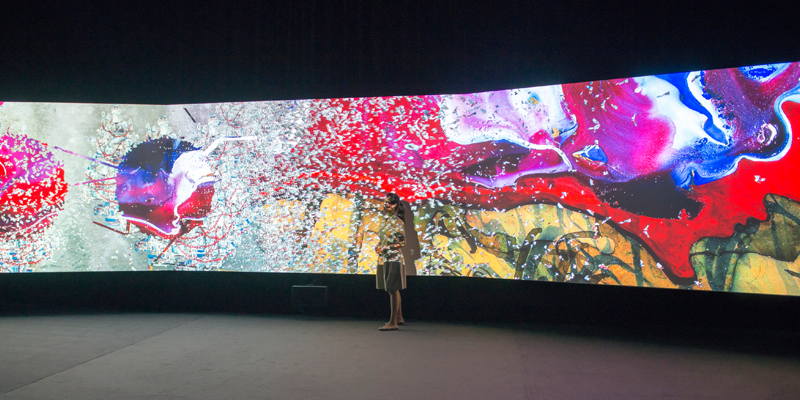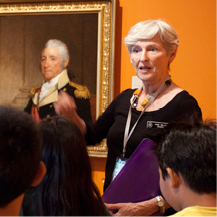
FOR IMMEDIATE RELEASE
Dec. 29, 2016
Media contacts:
Scott Whelden
Tel: 808-532-8719
Email: swhelden@honolulumuseum.org
CONTEMPORARY ART STAR SHAHZIA SIKANDER'S INSTALLATION ʻPARALLAX' OPENS MARCH 16
WHAT: Shahzia Sikander: Parallax
WHEN: March 16–July 30, 2017
WHERE: Honolulu Museum of Art, 900 S. Beretania St., Honolulu, HI
COST: Museum admission $10 general, free for children age 17 and under
INFO: Phone, honolulumuseum.org (publishable)
High-res images available on request.

HONOLULU, HAWAI‘I—This spring, the Honolulu Museum of Art presents Shahzia Sikander: Parallax, internationally recognized artist Shahzia Sikander’s immersive three-channel video animation created for the Sharjah Biennial 11 in 2013.
A groundbreaking and cinematic work inspired by the artist’s trip to the United Arab Emirates, with original score composed by Du Yun, in collaboration with poets from Sharjah, Parallax deals with the history of maritime trade in the Strait of Hormuz—the narrow passage between the Arabian Gulf and the Gulf of Oman where one-fifth of the world’s oil passes—particularly the fraught history of imperial control. Parallax exemplifies Sikander’s signature technique of animating small freehand sketches to disrupt space by transforming the drawn into digital space through movement at expanded scale.
The installation, projected on a curved, 45-foot wide screen, is composed of hundreds of digitally animated images taken from Sikander’s watercolor, gouache and ink paintings. Visitors can take a seat in front of the screen and let mesmerizing imagery flow over them, as it builds in intensity over 15 minutes and 25 seconds.
The 2013 Sharjah Biennal theme was “Re:emerge Towards a New Cultural Cartography,” and Parallax is “a map of sorts,” explains Sikander, “using as its agency painting, music, and poetry to inspect forms, ideas and emotions in a multivalent language. The interdisciplinary and collaborative thrust of Parallax is its unique template, its DNA. One of the fundamental questions I had to address when making Parallax was how to position my relationship to Arabic. Though the score in Arabic has specific meanings, also available via translation, for me the presence of Arabic in the music has a power that lies in my childhood and still-conflicted adult experience of the ritual of learning to recite the Quran in Arabic without understanding the language. Without grasping meaning I became familiar with the lyricism, melodiousness, and hypnotic power of the language’s sound. The call to prayer in Arabic is often made by someone with a powerful voice. Written Arabic has a visually arresting structure, with methodical and sophisticated geometric underpinnings closely related to architecture. It is in this sense that Parallax is an emotional map that envelops its viewer through sound and color into a landscape of history, simultaneously aerial and internal, mysterious and present.”
On the screen, abstract, representational and textual forms coexist and jostle for domination. Sikander takes motifs such as the stylized hairdo of Gopi women who worship Krishna and has them flying in swarms, like a starling murmuration. What appear to be Christmas trees are constructions of valves and spools—like oil rigs, spouting black gold. Human voices recite Arabic poems and narrate, creating tension and rhythm while oscillating between audible texts and the environmental sounds.
The animation is rich with meaning, drawing inspiration and making reference to such cultural touchstones and events as oil, the region’s dramatic shift triggered by the end of the pearl harvesting culture, air routes, piracy, the trading history of Ras al-Khaimah, and imported labor.
“The work is about conflict and control, but even more essentially it is about the mystery and elusiveness of freedom,” explains Sikander. “It is also about memory, how we recall and rewrite our experiences. Parallax investigates the blurred boundaries between fiction and nonfiction, storytelling and historical record, calling into question issues around redaction, the perception of authority, and independence.”
Parallax has been shown at Guggenheim Bilbao, Tufts University Art Gallery, and the Istanbul Biennale, among other venues.
This exhibition is made possible by the generosity of Sharon Twigg-Smith.
Halekulani is the hospitality sponsor of Shahzia Sikander: Parallax.
Free lecture
Shahzia Sikander: Parallax
March 17 • 5pm • Doris Duke Theatre • Free
The artist will talk about the meaning and the
making of her installation.
About Shahzia Sikander
Shahzia
Sikander is no stranger to O‘ahu. She was an artist in residence at Shangri La
in 2008, and she gave a talk at the Honolulu Museum of Art in 2015, as part of
programming for the exhibition Doris
Duke’s Shangri La: Architecture, Landscape, and Islamic Art. Sikander received her BFA from the National
College of Arts, Lahore, Pakistan and an MFA from the Rhode Island School of
Design, Providence. She has been the recipient of numerous awards, grants and
fellowships, including the 2016 American Academy of Religion and Art award, the
inaugural Medal of Art by the US State Department (2012), the John D. and
Catherine T MacArthur Foundation Achievement award (2006-2011); the National
Pride of Honor by the Pakistani Government (2005), the Joan Mitchell award
(1998-999), and the Tiffany Foundation award (1997). She lives and works in New
York City.

-end-
To UNSUBSCRIBE, please click here.
To join, e-mail lgriffith@honolulumuseum.org , or call (808) 532-6091.
About the Honolulu Museum of Art
One of the world’s premier art museums, the Honolulu Museum of Art presents international caliber special exhibitions and features a collection that includes Hokusai, van Gogh, Gauguin, Monet, Picasso and Warhol, as well as traditional Asian and Hawaiian art.
Located in two of Honolulu’s most beautiful buildings, visitors enjoy two cafés, gardens, and films and concerts at the theater. The museum is dedicated to bringing together great art and people to create a more harmonious, adaptable, and enjoyable society in Hawai’i.
Locations:
Honolulu Museum of Art: 900 S. Beretania Street
Honolulu Museum of Art Spalding House: 2411 Makiki Heights Drive
Honolulu Museum of Art School: 1111 Victoria Street
Honolulu Museum of Art at First Hawaiian Center: 999 Bishop Street
Honolulu Museum of Art Doris Duke Theatre: 901 Kinau Street (at rear of museum)
Website: www.honolulumuseum.org
Phone: 808-532-8700
Hours:
Honolulu Museum of Art: Tues–Sat 10 am–4:30pm; Sun 1–5 pm; closed Monday.
Honolulu Museum of Art Spalding House: Tues–Sat 10am–4pm; Sun noon–4pm
Admission (permits entry to both museums on the same day):
$10 general admission; children 17 and under are free.
There’s a lot happening at the Museum!
![]()
![]()
![]()
![]()
Unsubscribe | Forward | View in browser
You are receiving this email because of your interest in the Honolulu Museum of Art.
Honolulu Museum of Art 900 S Beretania St Honolulu, HI 96814


